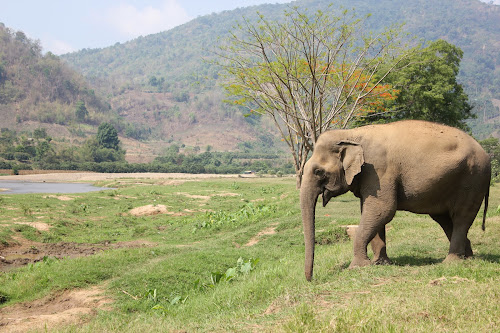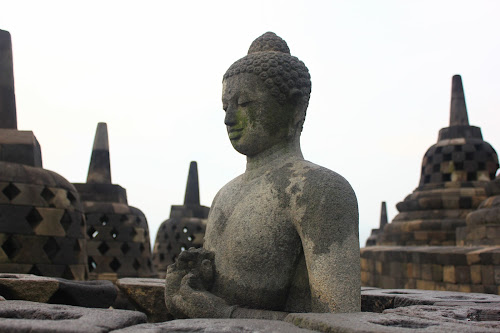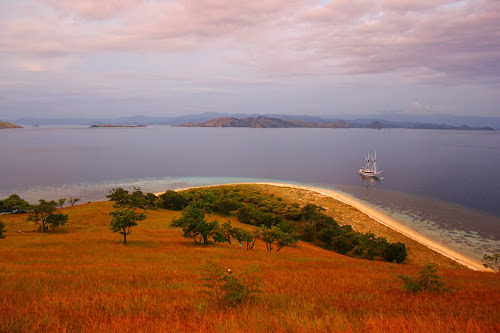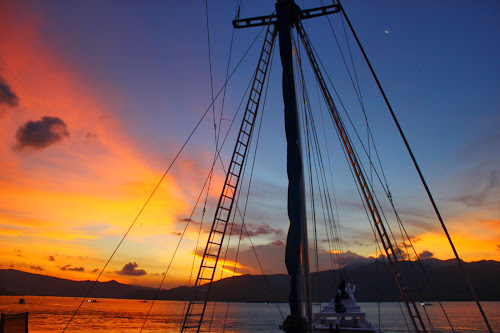"We can do no great things; only small things with great love."
Mother Teresa
I'm not so sure about that, actually. I think if a person has the capacity for genuine great love then they have the ability to do 'great' things.
Enter: Lek. A shining example of great love if ever I saw one. This tiny Thai lady is almost single-handedly trying to save the domestic elephant population of northern Thailand from its extinction. She is a crusader and a hero; she is a remarkable woman who shows exactly what one person is capable of if they care deeply enough.
The elephant is my favourite animal bar none. I love, love, LOVE elephants. They're peaceful and graceful and have abundant strength - as vegans, no less! It is said that they, alongside dolphins, are the only animals capable of human emotion so they feel stress, sadness and fear just like we do.
They also helped to build Asia. Because of this, they're revered and worshipped in shrines all over the continent. How can it be, then, that they're so badly abused here? The answer is: tourism and the logging industry.
Not-so-Fun Fact time. All animals are wild. They can't be turned into pets or 'domesticated' without some sort of training to make them obedient or behave in a way acceptable to us. When animals are required to work for humans rather than be pets this training isn't kind or patient but is likely to involve beatings of some kind. However, there's no beating in the world like an Asian phajaan.
The phajaan ritual is an act of making elephants submissive and obedient. The aim is to break their spirits. A baby elephant is taken from its mother and spends around a week in a tiny wooden cage with chains binding its feet tightly together and a rope around its neck hanging from the top of the cage so that it can't sit without strangling itself. The baby is continuously tortured until it has no will left whatsoever.
In Thailand, the heads of each village advocate the tradition and encourage further beatings if the elephant shows distress and tries to escape because they're adamant that this is the sole way to tame this magnificent animal. It's the only way to "separate the elephant's wild spirit from its body." I don't want to judge people who carry out the tradition because it's been part of life for them for thousands of years; it's the only thing they know. However, I'm not gonna lie to you - it's difficult not to. We saw a video of the phajaan and I bawled my eyes out. To actually watch people carrying out such acts of cruelty is a sight I'd rather forget. In some cases, the mother is held captive nearby and can be heard wailing for hours on end at the sound of her still-nursing child being battered.
The elephants are whipped, beaten and stabbed constantly with blade-tipped poles; the people whip slingshots into their eyeballs and poke them with blunt sticks in the eyes, ears, mouths and feet. They suffer terror-induced diarrhoea. Sticks with thick nails on the end are driven into the animal's flesh; if you imagine how tough and thick an elephant's hide is you'll understand how easily most nails become wedged in their skin and how painful it is to pull them out. A sharpened hook is thwacked into the baby elephant's skull - right between the eyes - with a thudding sound and has to be worked back and forth to pull it out and smash it into the skull again. And again. And again. The babies are not fed or watered and are sleep-deprived just to screw with them that little bit more.
Imagine if it were us humans being put through something like this. Think of mothers and children and what they would be going through. Now remember this fact again: elephants feel emotions like people. While some people may not agree with this completely, studies have shown that they do at the very least feel terror, anguish and misery in the same way, and the phajaan causes all of these. Many mother elephants cannot work again after the trauma of hearing their babies being tortured and show the same signs of post-traumatic stress disorder that humans do.
When it is sensed that the spirit has left the elephant's body, the baby will be released from the cage but it won't be free from being beaten further. There is a belief that an evacuated spirit means child and mother won't recognise each other if they ever cross paths in the future and this is essential to keep them both working. Such 'domestic' elephants are considered by law as livestock, so have no more protection than chickens or goats. The phajaan ritual is said to have started in the tribal communities of India and it's still standard practice in Asia today. Thailand is no more a culprit of 'taming' elephants in this way to have them perform in shows or to beg and do tricks on the city streets for tourists than any other country but, after logging was made illegal here, the number is far greater. In places where logging is still legal, such as Burma, there may be less elephants in shows but far more working as slaves.
Elephants feel vibrations through their feet and being in a big, scary city puts their senses into stressful overdrive. They don't belong in cities. So those shows tourists go to with dancing elephants? Products of the phajaan. Those elephants doing tricks like painting for amused onlookers? Phajaan. The elephants being walked around hotel resorts offering rides or walking down streets with bags of food from which tourists can feed them? Phajaan. Slowly but surely, due to this brutal practice, the domestic elephant population is in danger of dying out in our lifetime.
Someone needed to come along and care enough to try to change things. Someone did. That someone is Lek.
Her name is a moniker meaning 'small' in Thai. She certainly is tiny, dwarfed by the huge animals she works with, but nothing can outsize her gargantuan heart. The granddaughter of a tribal village leader and someone who grew up with elephants, Lek has a natural and deep connection with these almighty animals and is on a mission to save them from abuse and death. When she can afford to, she buys domestic elephants from their owners and rehabilitates them at her amazing Elephant Nature Park. She can't buy currently working animals but people are willing to sell her maimed or old elephants as well as those who have become mentally ill through excessive suffering. Lek has received many death threats and even had the youngest baby elephant at the park poisoned to death.
The Elephant Nature Park lies 60km outside of Chiang Mai and is home to 35 rescued elephants. After the floods in Thailand in 2011, it's also home to 300 rescued dogs. Quite a few buffalo, too! We heard about this place from the daughter of an Alaskan couple we met on our boat in Halong Bay and we were simply desperate to go there. We did whatever we could to squeeze it into our schedule but only had a handful of days to spare; many volunteers work here for long periods of time. Visitors can, of course, just come for a day trip or an overnight visit and enjoy the animals. Elephants need A LOT of food so we were feeding them constantly. Whole pineapples and bunches of bananas were wolfed down in one swift motion. We bathed them in the river and Imran even got a kiss from one! (Trained to do so through positive reinforcement methods.) They were regal, beautiful and just plain awesome.
Lek set up the ENP despite extreme financial difficulty but her genuine love and passion got her through. It takes nearly a quarter of a million dollars to keep the park running each year, mostly because the elephants need around 88,000 kg of fruit and veg per animal per annum! It can't run without vital donations which is why visitors are welcomed here in their hoardes every day. We 'adopted' three elephants for our nieces and this will cover the cost of their care for a few years. Introductions, please:
Jokia worked in the logging industry until it was made illegal and she had to be sold by a family who could no longer afford to keep her. She was pregnant at the time. She continued working illegally elsewhere and gave birth whilst pulling logs up a hill. The baby tumbled down the hill and died. Jokia became so traumatised that she refused to work anymore, so her owner beat her left eye with a slingshot until she was blinded. She tried to continue working but her sadness overcame her. The owner thought a completely blind animal would be more cooperative so he shot her other eye with a bow and arrow and blinded her completely. As you can imagine, this resulted in her feeling more terrified and angry but the only thing her mahout (owner) knew to do was keep beating her. The first time Lek came across Jokia, her body was covered in scars and infected wounds and she was crying. Thankfully, Lek managed to convince the mahout to sell Jokia to her.
Hope was a baby when he came to the Elephant Nature Park. His mother had died when he was just 1 and he was both physically ill and against human contact. Full of fear, he was a challenge to have at the Park at first; his behaviour was unpredictable. Lek used to tiptoe quietly into Hope's area at night and sleep with him until she eventually gained his trust. He is now one of the most vibrant and colourful personalities at the ENP.
Medo suffered a broken ankle whilst she was working illegally after logging was banned and became unfit for labour. Elephants with injuries like this are deemed fit for only two purposes: street begging where they can get 'sympathy cash' from tourists, or forced breeding programmes. Medo was put into the latter. Whilst chained up, she had a male elephant forced on her but sadly this bull was in 'musth' - a period of heightened sexual tension during which the animal becomes especially aggressive. The elephant savagely attacked Medo and she ended up lying on the ground alone for two days. Later, it was learned that her backbone had been dislocated and her pelvis broken from the attack. Medo lived in an isolated location so it is unlikely she was ever seen to, but after a brutal assault like this, she would not be able to get pregnant. Unable to work or be a breeding machine: the only consolation for a beautiful animal treated this way is that she now lives at the ENP. Other elephants at the Park have their own horrific pasts; there are those that have injuries beyond comprehension from abuse or from stepping on landmines, and those that worked in tourist shows so start dancing automatically as soon as they see people. It is unbelievably heartbreaking to see. I have to fight back chokes and tears even as I write this.
Watching Lek with the elephants is a wonderful sight. She spends all day with a new elephant and sleeps with them during the night if need be (and during their recurrent nightmares) until they finally trust her. The obvious love she has for the animals and they for her is beyond belief; it's humbling, fascinating and extraordinary. This woman is something else. What a role model for the world. She is the most admirable woman I've ever had the pleasure of meeting. Stand up and take a bow, Lek: you've shown that one person really can make a difference.
When it comes to shows, especially in Thailand, all that needs to be done is to ask if animals are involved and then refuse to buy a ticket. The short-term fun of feeding or riding one on holiday isn't worth their long-term pain. The mahouts try to convince tourists that if the elephants don't work, they will be abandoned or killed so this type of work saves their lives. Call their bluff. Mahouts in Asia don't know any other work aside from elephants and they'll never dump one because it would be no different to dumping a bag full of cash. In Laos we saw many, many so-called, self-proclaimed 'conservation projects' that allowed tourists to ride the animals and called it 'elephant preservation,' but they were simply trying to take advantage of people's simultaneous concern for elephants' welfare and lack of knowledge. Ultimately, for an elephant to allow someone onto its back, it's been through the phajaan. In Bali airport there were adverts for 'exciting' cultural shows, complete with dancing animals. It's everywhere in this part of the world. The Elephant Nature Park shows tourists that they can enjoy them without riding them, and here they get to feed and bathe them in a safe environment. Mahouts have the option to sell their animals to rehab centres if the usual tourist options are no longer available to them; their skills and knowledge could also be used in the form of jobs if they were so inclined. There are a lot of traditions in the world that have gone on for a long time but have no place in the modern age. Traditions can be changed. The phajaan is one of them. I'm not saying that no elephants should be domesticated (yet) and I'm not even saying that remote clans who use this ritual should be made to abruptly stop without any help or information about alternative methods of domestication that won't offend their cultural sensibilities. However, for people who only use the phajaan to domesticate an elephant for tourism, this has got to stop NOW.
Let's put an end to this bullshit. Just Say NO.
"The elephant hath joints, but none for courtesy; his legs are for necessity, not for flexure."
William Shakespeare
"There is no creature among all the beasts of the world which hath so great and ample demonstration of the power and wisdom of almighty God as the Elephant." Edward Topsell
To help, please visit: http://www.elephantnaturepark.org/howyoucanhelp.htm







































